Marvellous mosaics around the world
Small but mighty

Mosaics – small-tiled artworks made from coloured materials – can decorate almost any surface. From floor-to-ceiling interiors to standalone sculptures, this ancient art form has been expertly crafted over the years to create delightfully intricate pieces and tell important stories.
Here’s our round-up of stunning mosaics you can see around the world, arranged from the oldest to the most recent...
The Alexander Mosaic, Pompeii, Italy

One of the most famous mosaics in antiquity, The Alexander Mosaic was found at the House of the Faun in Pompeii and dates to 100 BC. There’s a catch – this is a Roman copy (by Aristides of Thebes) of a lost Hellenistic Greek original.
The scene depicts the Macedonian-Greek leader Alexander the Great charging across the battlefield on horseback while the Achaemenid Persian leader Darius III looks back as his chariot whisks him away. Believed to show the Battle of Issus of 333 BC, visitors today can see it on display at the National Archaeological Museum in Naples.
Head of Medusa, Volubilis, Morocco
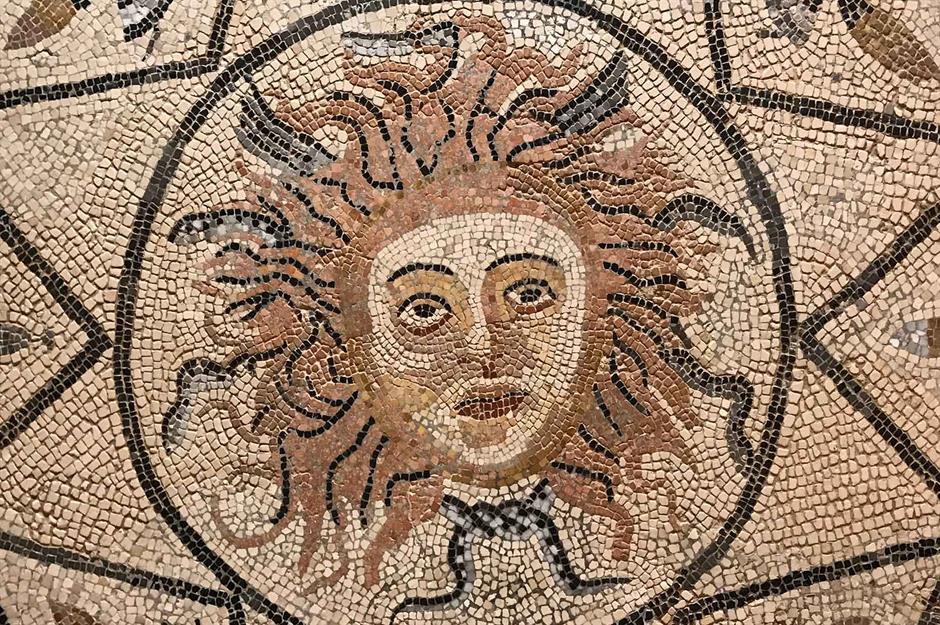
Art of the head of Medusa was popular in ancient Greek and Roman homes as a way to ward off evil. The mosaic pictured here was discovered in the ancient Roman city of Volubilis near Meknes, Morocco.
The haunting stare from the girl-turned-gorgon (anyone who looked into Medusa’s eyes instantly turned to stone) is part of a large floor mosaic in the House of Orpheus and dates back to roughly AD 150-200.
Gladiator Mosaic, Nennig, Germany
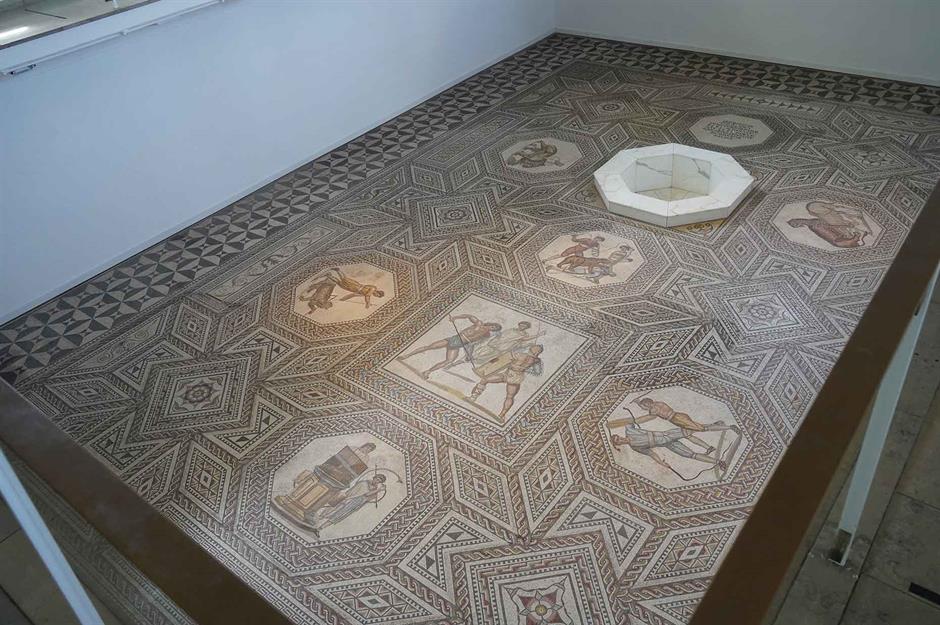
This extraordinarily well-preserved Roman mosaic dates back to around AD 201-300. It was situated in the atrium (reception hall) of a sprawling villa in Nennig, by the river Moselle where Romans settled over 2,000 years ago.
Its geometric style depicts an organist and horn player and various gladiator and hunting contests – there’s a javelin thrower with a panther, a tiger versus a wild mule, a lion and his keeper, three fighters versus a bear, two fighters versus each other and three fighters versus each other. This well-preserved mosaic was only rediscovered by chance in 1852.
Villa Romana del Casale, Sicily, Italy

This one-of-a-kind mosaic was created between AD 301 and 400 and discovered in a small room at the Villa Romana del Casale, Sicily. Commonly dubbed ‘the bikini girls’, the mosaic actually depicts women engaging in sport.
We can tell this from the leather loincloths and linen breastbands they're wearing, as well as the weights and discus carried and two figures running. The type of tesserae (mosaic stone) used implies the mosaic was almost certainly created by North African artists.
Trojan War Mosaic, Rastan, Syria

Located in Rastan in northern Syria, this recently discovered 1,600-year-old mosaic may have once formed the floor of an ancient bathhouse. The 1,300-square-foot (120sqm) art piece is a remarkably intact depiction of the Trojan War – a legendary conflict from more than 2,000 years ago between the ancient Greeks and the semi-mythical city of Troy.
Constructed in the Roman era, the mosaic shows soldiers carrying swords and shields, along images of the fierce Amazons said to have fought alongside the Trojans.
Madaba Map, Madaba, Jordan
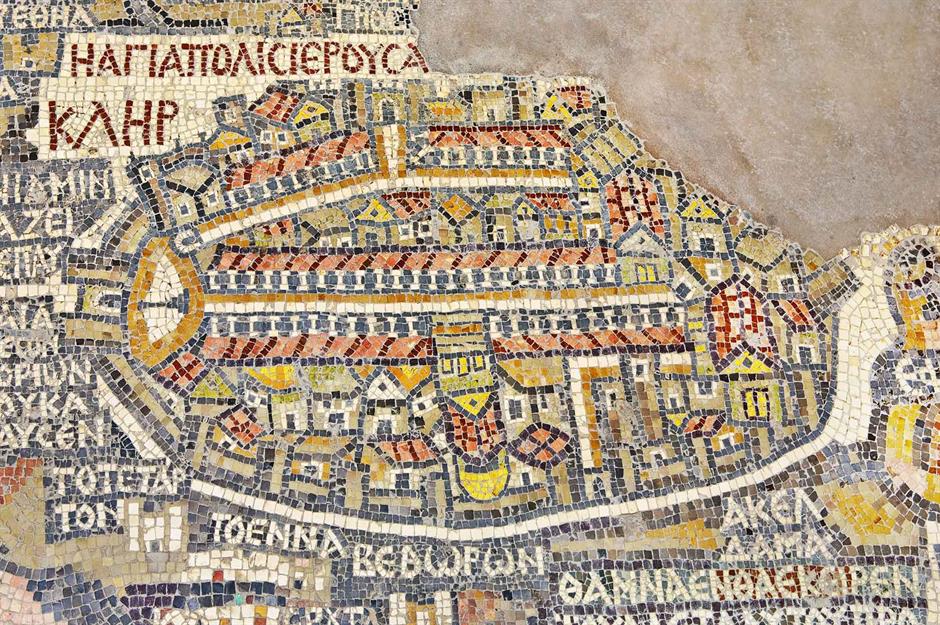
This floor mosaic is partially preserved in the Church of Saint George in Madaba, Jordan. Dating to between AD 542 and 570, the Madaba Map is one of the oldest examples of ancient cartography (map drawing).
Including inscriptions of places, Bible quotations and commentaries, the mosaic was used for Christian art representations rather than navigation and covered the area from Lebanon to the Nile delta and from the Mediterranean Sea to the desert in the east. Amazingly, it originally consisted of 23 million mosaic stones, but the artists are still unknown.
Cosmati Pavement, Westminster Abbey, London, England, UK
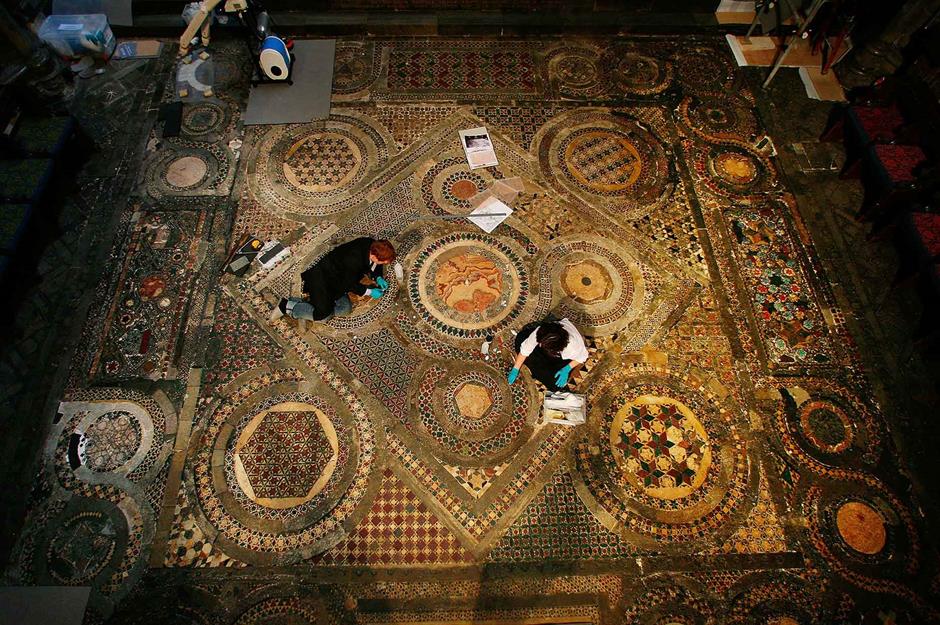
The Cosmati Pavement in London’s Westminster Abbey is a true feat of art. This 603-square-foot (56sqm) mosaic floor lies in front of the High Altar and was built in 1258 by King Henry III as a centrepiece of the abbey.
Headed up by Franciscan friar Odoricus and his team of workmen from Rome, the abstract design marks its difference from other 13th-century pavements in the complex. Inlaid pieces of semi-precious stone include purple porphyry, green serpentine and opaque-coloured glass – with some pieces thought to be recycled from ancient Roman ruins.
Shah Cheragh, Shiraz, Iran

From the outside, Shah Cheragh looks like an ordinary (yet still attractive) mosque and funerary monument, but inside it’s instantly clear to see why it’s nicknamed the mirror mosque. Its starburst-like effect of multi-coloured tiles is the result of mirror fragments and glass shards that cover the entire interior from floor to ceiling.
The present structure was constructed in the 14th century to include these incredible additions and is a popular site for pilgrims and visitors alike.
Nikia Mosaic, Nisyros Island, Greece
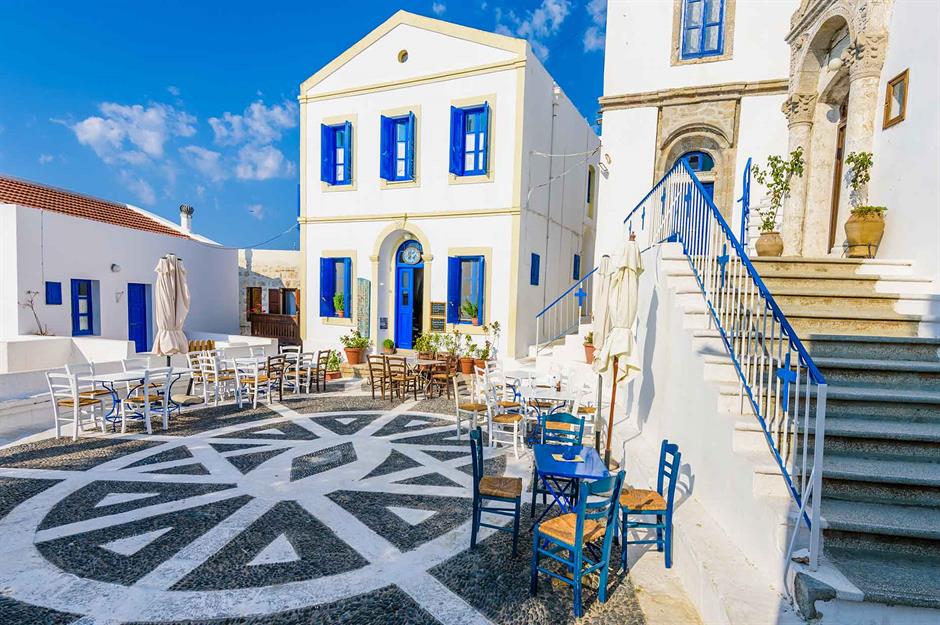
Nikia’s village square is paved with a beautiful black and white pebble mosaic in a style known locally as hochlakia. Simple yet effective, it makes for an ideal photograph opportunity. It was created by known local artist Paschalis Paschalakis during the 1800s.
This picturesque village is located on the volcanic Nisyros Island, part of the Dodecanese group of Greek islands between Kos and Tilos. Hochlakia mosaics can also be found in Lindos, Rhodes.
Mosaic mask of Quetzalcoatl, Mexico

This striking Aztec mask is made of ‘cedro’ wood and decorated with turquoise tiles. Dating to the early 15th century, it depicts two serpents entwined to form the mask with its twisted nose and large goggle-like eyes.
It’s still contested as to whether it depicts Tlaloc, the god of rain, or Quetzalcoatl, a feathered-serpent deity. The Tlaloc Priest known as Quetzalcoatl Tlaloc Tlamacazqui may have worn something like this. This mosaic mask is on display at the British Museum.
Kalta Minor Minaret, Khiva, Uzbekistan

Dazzling blue and green tiles cover the entire Kalta Minor Minaret in Khiva, Uzbekistan. As impressive as it is, construction actually stopped in 1855 when the ruler of the time died, leaving this short minaret to stand at a ‘mere’ 85 feet (26m) instead of the original estimated 240-360 feet (70-110m).
Glazed tiles and majolica, a tin-glazed earthenware, make up the intricate patterns. Located in front of the largest madrasah school in Central Asia (now a hotel), the barrel-shaped minaret stands out against the surrounding sand-coloured buildings.
The Old Bank, Stratford-Upon-Avon, England, UK

Blink and you might miss it, but this golden-backed William Shakespeare mosaic is well worth seeing. The playwright’s portrait sits above the main entrance of The Old Bank (now an HSBC bank branch), which was first built in 1810 but reopened with Shakespearean additions in 1883.
Crafted by Samuel Barfield, it's situated in the playwright’s birthplace of Stratford-Upon-Avon and the High Victorian Gothic-style building also features terracotta friezes of scenes from his revered plays.
Mosaik Brunnen, Zürich, Switzerland
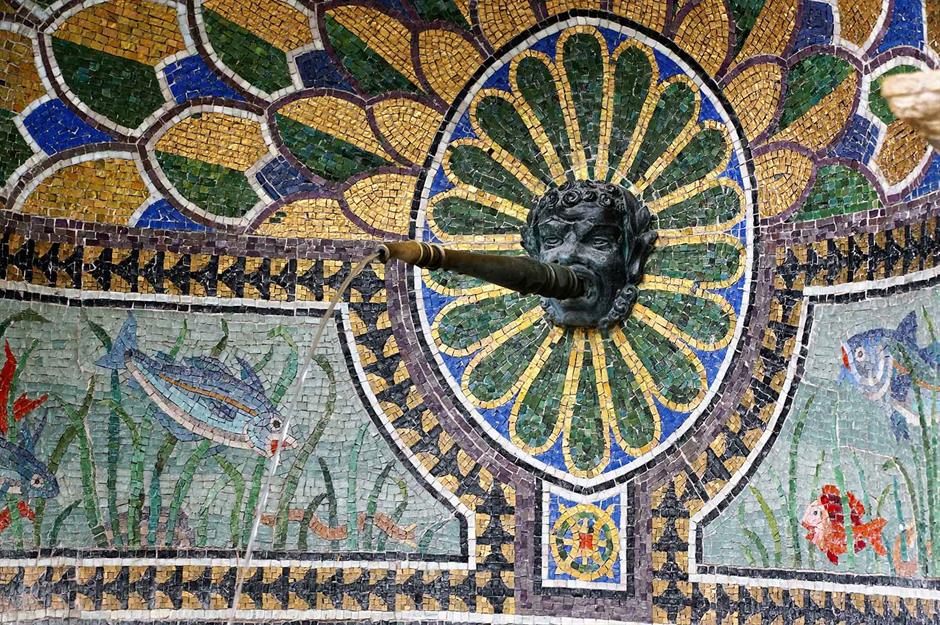
Zürich’s Mosaik Brunnen (Mosaic Fountain) is appropriately water-themed in its position near Lake Zurich. Yellow, blue and green tiles make up the ornate upper-half of the often-missed fountain while the lower half uses blue tiles to depict aquatic life. First created in 1909 by Alfred F. Bluntschli, pause for refreshment at this public fountain which is found along the leafy General-Guisan-Quai.
Parc Güell, Barcelona, Spain

There’s no missing Parc Güell in Barcelona. The terrace at the top of the park is a great vantage point over the city, but Antoni Gaudí’s hypnotic artwork is the real reason to visit. The winding Serpentine Bench uses tiles from a nearby factory while the famed lizard, or El Drac, guards the park (and is covered in Gaudi’s signature mosaics as well, of course).
Opened to the public in 1926, the bursts of colours that make up Parc Güell is an example of the Trecandís techniques, a chopped effect often used in Catalan modernist art – and one which Gaudí perfected.
St George’s Church, Topola, Serbia

Stepping inside St George’s Church on Oplenac Hill is instantly spellbinding. Some 40 million pieces of glass make up the ecclesiastical mosaics which cover the interior, including the marble floor and iconostasis (a tiered screen with icons). Also known as the Oplenac Mausoleum, this resting place of the Serbian royal family was founded by King Peter I and completed in 1930.
Central Library, Mexico City, Mexico
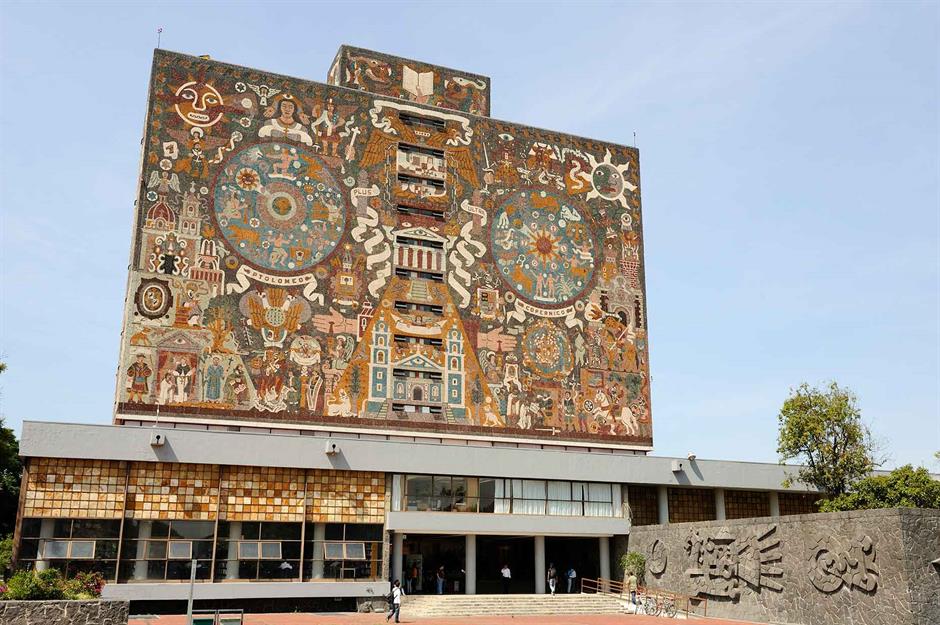
Standing 10 storeys high, the Central Library of the National Autonomous University of Mexico is tattooed in mosaics. The library opened in 1956 and its intricate art is the work of Juan O’Gorman. Considering its height, the level of detail is incredible, with multi-coloured local stones used.
Each wall represents a different era: the north wall depicts the pre-Hispanic period; the east wall, the modern era; the south wall, the colonial period; and the west wall the university’s history.
La Maison Picassiette, Chartres, France
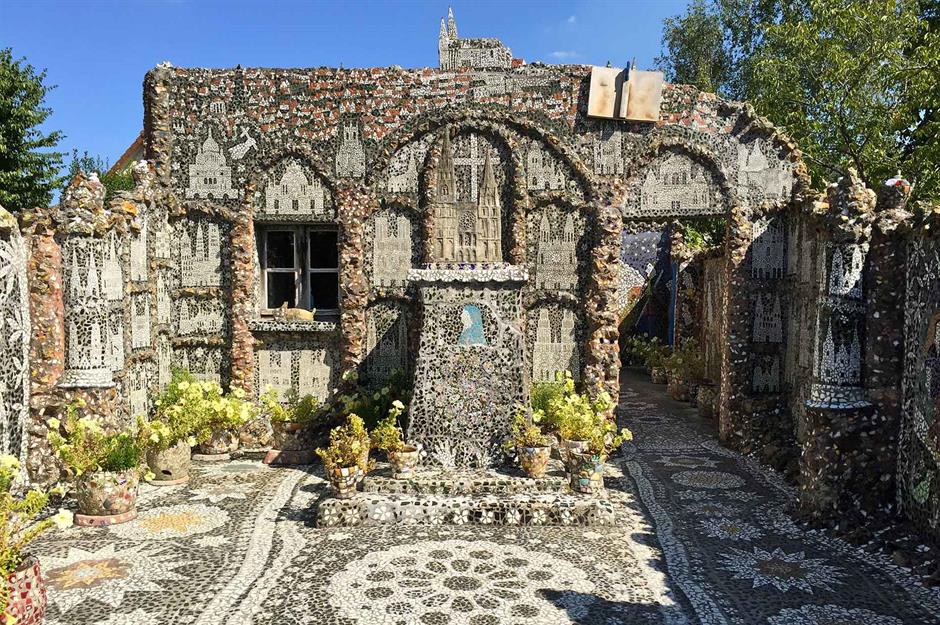
La Maison Picassiette is a mosaic-tiled house in Chartres, central France. Raymond Isidore decorated what seems like every visible surface of his home, including the walls, floors, gardens and even furniture.
The mosaics were formed from crockery, broken glasses and bottle caps and include the likes of flowers, animals and French landmarks. Isidore completed his ‘House of a Million Pieces’ in 1968. The house has changing opening hours throughout the year so it's best to check its website before planning a visit.
Australian Parliament House, Canberra, Australia

The forecourt of Canberra’s Australian Parliament House features this sprawling 2,100-square-foot (196sqm) mosaic revealed in 1988. Designed by Aboriginal artist Michael Nelson Jagamara, the huge artwork is based on the artist's Possum and Wallaby Dreaming painting which describes a gathering of a large group of people from the kangaroo, wallaby and goanna (a type of reptile) ancestors.
By using a modern interpretation of a sand-painting technique of the Warlpiri people, it reflects the country’s ancient beginnings, and is made of 90,000 individual hand-cut granite blocks.
Lexington Avenue-59th Station Subway, New York City, New York, USA

Passengers combine travel with art across subway stations in New York, from an aquarium mosaic at 81st Street-Museum of Natural History to a nature garden mosaic at Bedford Park Blvd-Lehman College.
The mosaic pictured here is the work of Elizabeth Murray and is affectionately titled Blooming in reference to Bloomingdales that sits above the station. The colourful tiles pour throughout the station’s walls and tunnels, which first appeared in 1996.
Campbell Parade, Bondi Beach, New South Wales, Australia
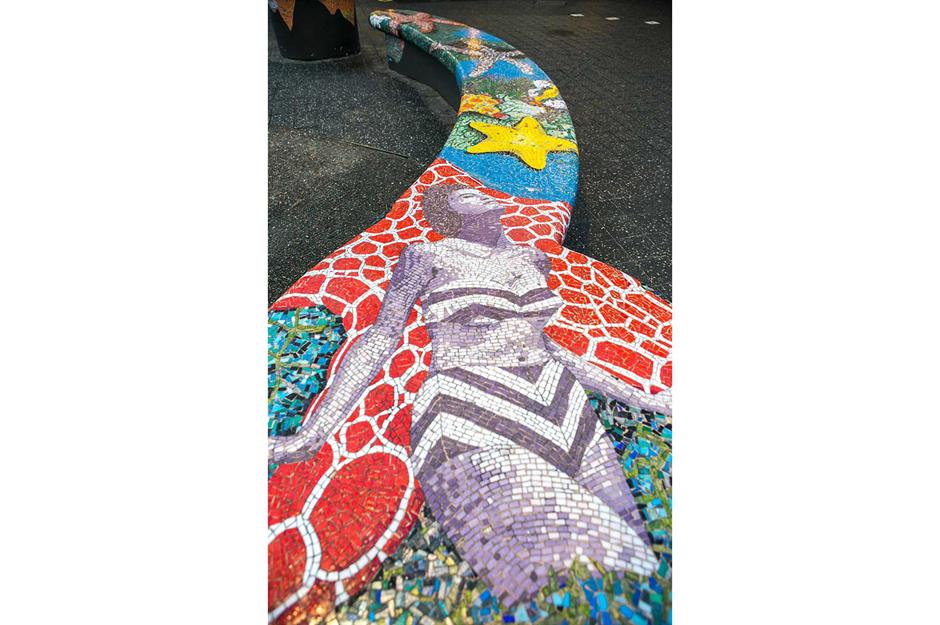
Spanning just over half a mile (1km) along Campbell Parade on Bondi Beach’s seafront, these colourful mosaics made their debut in 1999. Artists Helen Bodycomb and Enver Camdal depicted different aspects of Bondi’s cultural and natural histories, from lifeguards and surfers to public trams and sea creatures.
The 29 pieces of mosaic ‘street furniture’ are made up of long curved benches, high-backed seats, table tops, rondels (circular chairs), sculptured rails and armrests and more.
The Big Fish, Lagan, Belfast, Northern Ireland, UK

There’s big fish and then there’s The Big Fish, a 32-foot-long (10m) salmon by the Lagan Lookout and Customs House in Belfast. This unique piece of public art was created by Belfast-based artist John Kindness and was revealed in 1999.
It’s made up of large blue ceramic tiles. Look closer and you’ll see they describe different scenes from Belfast’s history, from newspaper clippings to medieval maps. Kiss the fish for wisdom (although you may not particularly look as if you have it while doing so…).
Selarón Steps, Rio de Janeiro, Brazil

With yellow, blue and green-tiled steps lined by bright red tiled walls, the Selarón Steps in Rio de Janeiro is one of the most-loved landmarks in the city. Created by Chilean artist Jorge Selarón in the 1990s and completed by 2000, it also features over 2,000 tiles donated by visitors from 60 countries.
The public steps also go by the name Escadaria Selarón and mark the border between the Santa Teresa and Lapa neighbourhoods.
Queen Street, Edinburgh, Scotland, UK

The unofficially named Thistle Mosaic was installed as pavement art by Lancashire-based artist Maggy Howarth. This pebble mosaic depicts Scottish fauna contained in the most Scottish of flora: the thistle. Visitors can find it (and unassumingly pass it by) on Edinburgh’s Queen Street, in a courtyard to the right of the Scottish National Portrait Gallery. Could this be the most patriotic artwork in Edinburgh?
The Giant’s House, Akaroa, New Zealand
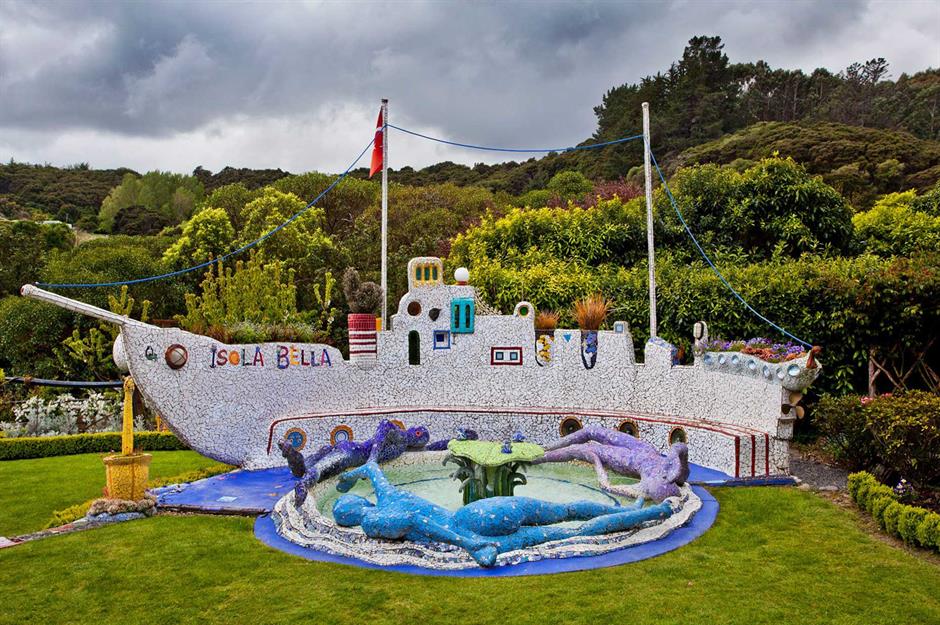
There’s no single image that can sum up The Giant’s House in Akaroa, South Island. Abstract artist and sculptor Josie Martin opened this colourful wonderland to the public in 2000 after she’d been inspired to create art from the crockery shards she’d dug up in the garden.
The zany site is filled with large sculptural mosaics where you’ll come across the likes of full-size pianos, silver-tiled hares, animal-headed characters, topless couples on benches… the list goes on.
Antarctic 100 Memorial, Cardiff Bay, Wales, UK
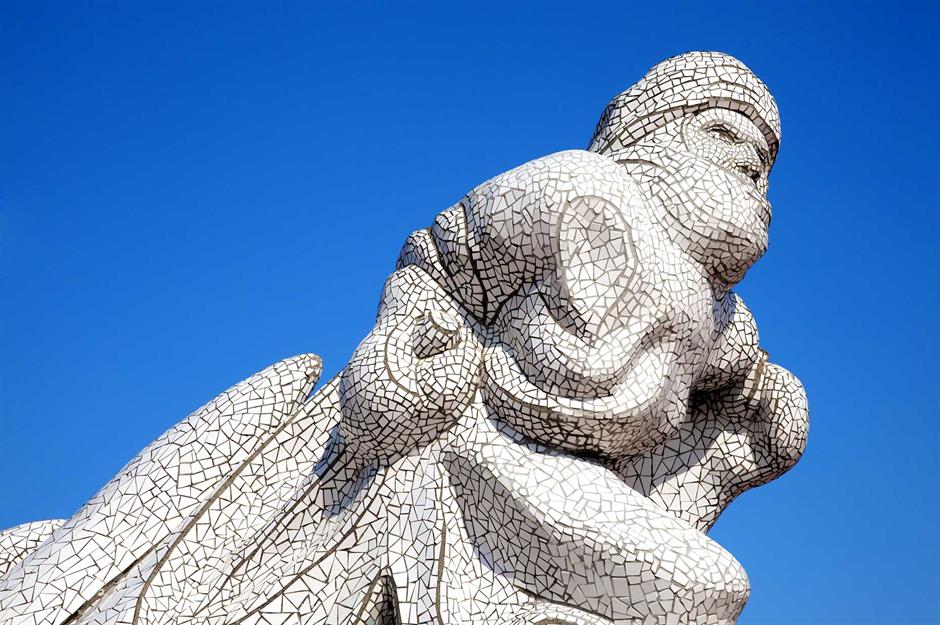
The striking Antarctic 100 Memorial, located in the waterfront park of Cardiff Bay, was unveiled in 2003. This mosaic was sculpted by Yorkshire-born artist Jonathan Williams to commemorate Captain Scott.
The British explorer had departed Cardiff for the South Pole in 1910 on his second expedition to the Antarctic. But it was fatefully his last, as he died in freezing conditions in 1912. The memorial depicts Scott surging forwards, the faces of his crew trapped in the snow and the foresails of their Terra Nova ship at the rear.
Wat Pha Sorn Kaew, Khao Koh, Thailand
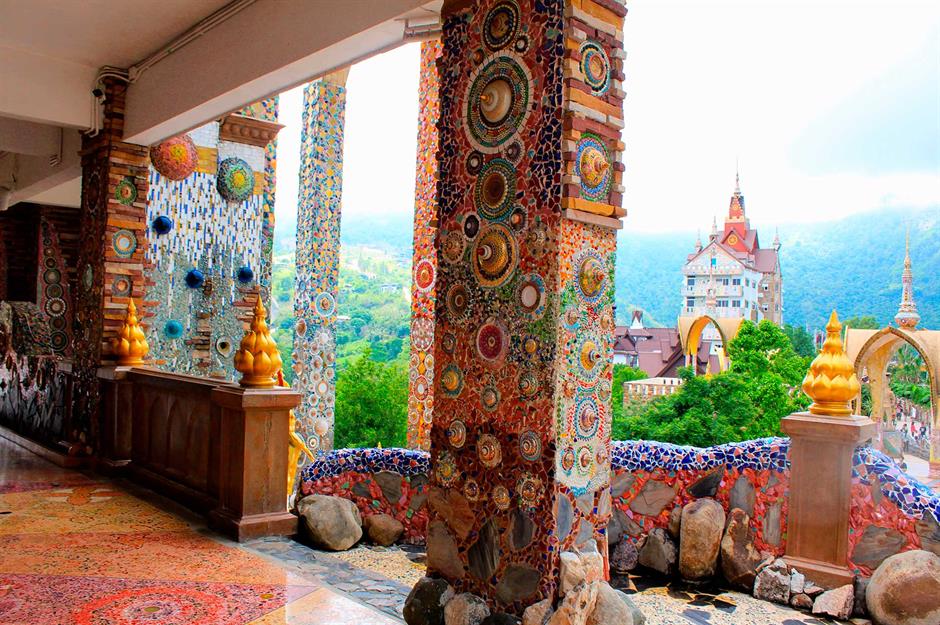
Colourful, quirky and calming all at once, Wat Pha Sorn Kaew is unique in its own right. This Buddhist monastery was completed in 2004 and achieved temple status in 2010.
It sparkles against the green mountains in northern central Thailand with over four million mosaic tiles, pottery shards and teapot fragments cascading over the surfaces. Visitors should sit in the middle of the mosaic for good luck – or to simply soak up this Thailand-meets-Barcelona hillside retreat.
Sheikh Zayed Grand Mosque, Abu Dhabi, United Arab Emirates

The courtyard (Sahan) of Sheikh Zayed Grand Mosque in Abu Dhabi is one of the largest marble mosaic artworks in the world, covering 187,300 square feet (17,400sqm). After the mosque opened in 2007, the courtyard underwent extensive restoration work between 2019 and 2020 where 9.5 million pieces were returned to their shining glory.
Created by British artist Kevin Dean, there's a calming botanical theme of native flowers from the Arabian Peninsula, including tulips, lilies, irises, roses, jasmine and passiflora.
Philadelphia’s Magic Gardens, Philadelphia, Pennsylvania, USA

Philadelphia’s Magic Gardens first opened to the public in 2008 and is an eco-minded spectacle. Made up of two indoor galleries and a bi-level outdoor sculpture garden, this downtown Philly art environment is decorated with handmade tiles, bottles, bicycle wheels, mirrors and international folk art.
The art tells the story of the creator’s life, Isaiah Zagar, who is an award-winning mosaic mural artist heavily influenced by his travels.
Hanoi Ceramic Mosaic Mural, Hanoi, Vietnam
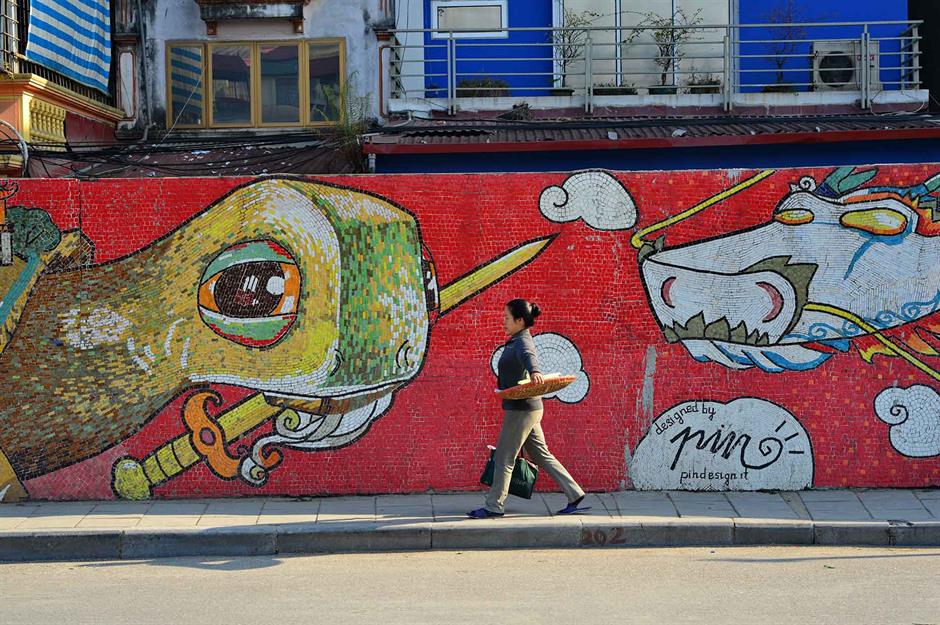
Completed in 2010 to mark the millennial anniversary of Hanoi, the Ceramic Mosaic Mural is the world’s largest ceramic mosaic, spanning 2.5 miles (4km) in length. What was once a grey concrete dyke was transformed into 21 sections of vibrant, colourful murals showcasing Vietnam’s history of decorating styles.
Some 20 Vietnamese and 15 international artists collaborated on the three-year project, using tesserae (individual mosaic pieces) produced in nearby Bat Trang village.
Piazza Mosaic, Port Elizabeth, South Africa
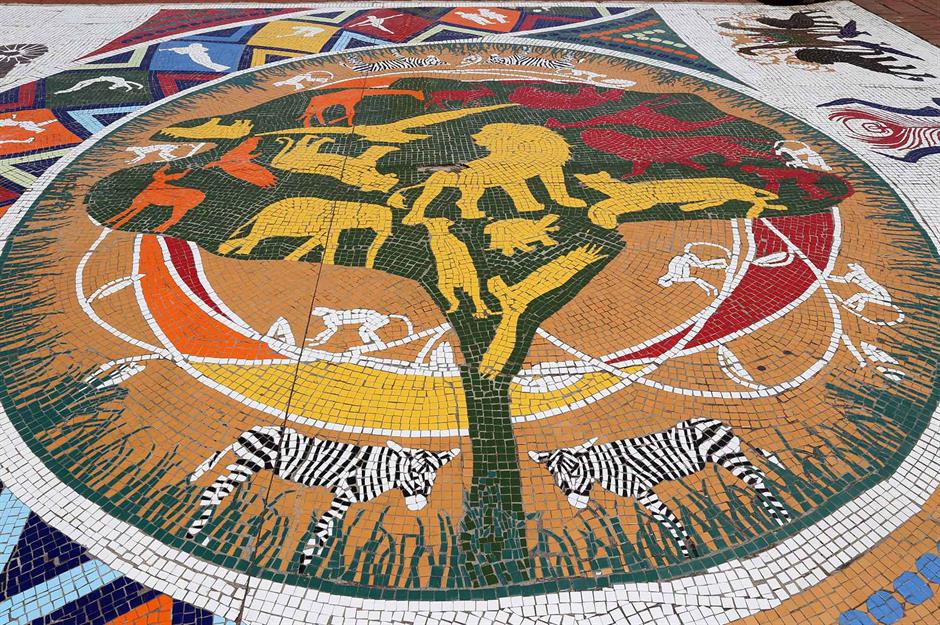
Port Elizabeth, a coastal city between Cape Town and Durban, is home to this story-telling mosaic. Route 67 is a public-art heritage walk that comprises 67 public artworks. The works were created by local artists to represent Nelson Mandela’s 67 years of political life.
This section of the mosaic is part of the 5,050-square-foot (470sqm) Piazza Mosaic and depicts the city and province’s history. Unveiled in 2011, the mosaic depicts indigenous people, settlers, sports personalities and more.
Baie St Paul Mosaic, Quebec, Canada

To commemorate 150 years of Canada’s dominion, local communities created mosaics to tell their own city’s story. The mosaic pictured here was unveiled in 2015 and portrays an artist at work. This reflects Baie St Paul’s association as the Cultural Capital of Canada – the small city has the highest number of art galleries in the country per capita. There are almost 90 other similar mosaics on display across the country.
Sichuan Fine Arts Institute, Chongqing, China
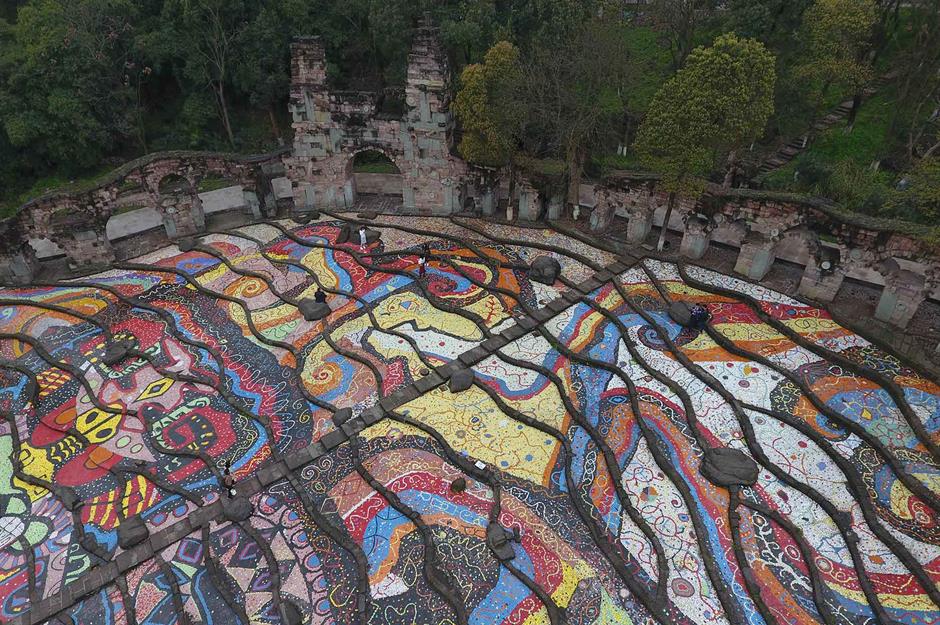
Often described as a ‘ladder of colour’, these glazed mosaics appear more like the rice terrace fields that China is so well-known for – albeit in loud splashes of red, blue, orange and yellow. The unique swirls of colour were created in 2017 by students at the prestigious Sichuan Fine Arts Institute in southwest China’s Chongqing.
Visitors can see the bricks, slates and broken tiles that make up the site for themselves at the institute’s east gate.
Maradona mosaic, Buenos Aires, Argentina
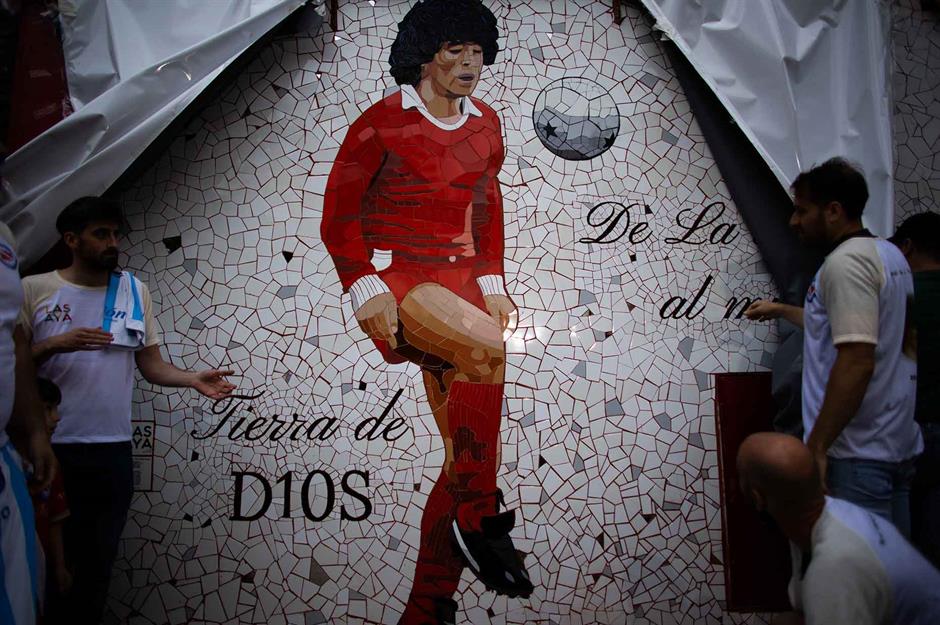
Diego Armando Maradona’s footballing legacy continues in mosaic form. Cultural organisation Comando Maradona have created various mosaics of the icon in public spots across Buenos Aires. This one pictured here, unveiled in 2021, was most likely created by the same group, although it’s not confirmed. Maradonna played for Argentina between 1977 and 1994 and died in 2020, aged 60.
Comments
Be the first to comment
Do you want to comment on this article? You need to be signed in for this feature